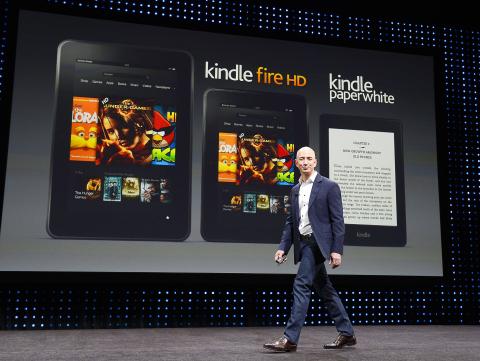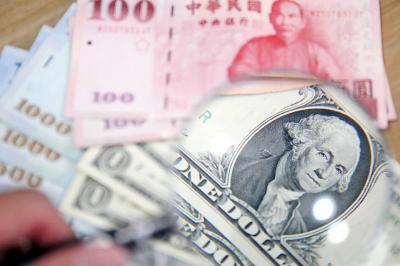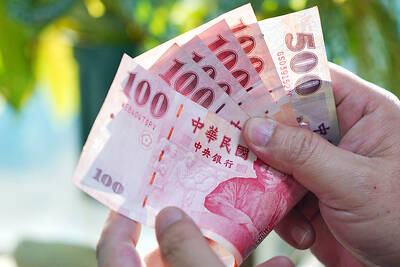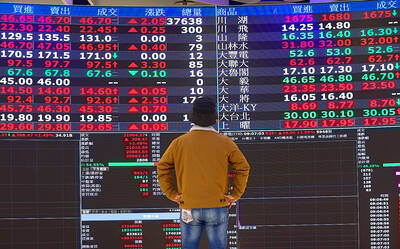Amazon.com Inc unveiled larger Kindle Fire tablets on Thursday, challenging Apple Inc’s dominant iPad with lower prices and a trove of digital content that Amazon hopes will win it a bigger share of the booming tablet market.
The world’s largest Internet retailer lifted the lid on devices with price tags ranging from US$159 to US$599. The new tablets come with ads known as “special offers” that appear when screens are locked and in the corner of the home screen, helping Amazon keep prices low.
Last year, Amazon debuted a 7-inch tablet at roughly half the price of the US$499 iPad. In just 10 months, it became the No. 2 tablet in the US, after the iPad.

Photo: EPA
Amazon’s expanding lineup also intensifies a battle with Google Inc and Microsoft Corp, which this year entered their own competitors in the booming tablet arena.
The latest aggressive pricing move, in addition to Amazon’s variety of gadgets, furthers its goal of getting Kindle tablets into the hands of as many buyers of its online content — from games and books to video — as possible.
Apple, by contrast, makes much of its profit from hardware sales. It sells a single-sized iPad often touted as best-in-breed, at prices ranging from US$399 to US$829, depending on storage capacity, screen resolution and wireless connectivity.
Amazon will begin shipping on Nov. 20 an 8.9-inch version with a high-definition screen that works off either Wi-Fi or 4G wireless broadband. The priciest version — at US$599 for 64 gigabytes of storage — undercuts the top-of-the-line US$829 iPad.
“Their first Kindle Fire tablet was a device that said ‘See, we can tie all this together,” but it wasn’t a strong enough device,” Forrester Research analyst James McQuivey said.
“Now they’ve really come ready to show that their device line-up is going to be as good as their service line-up. They’re tying those two things together, and at a price that is very, very hard to compete with. It’s going to push everybody else’s price buttons — including Apple’s,” he said.
The premium Kindle Fire HD has a 1,920 by 1,200 resolution screen, lagging Apple’s so-called “retina” display. At 8.9 inches, it is also slightly smaller than the iPad’s screen.
At the other end of the spectrum, the cheapest 7-inch Wi-Fi only Fire goes for US$159. Apple’s lowest iPad price tag is US$499.
Amazon CEO Jeff Bezos, taking the stage in Santa Monica, California, said the company wants to make money when people use its devices, not when they initially buy them.
While Bezos did not mention Apple by name during his presentation, the company compared its new tablets to the iPad several times in its press release describing the devices.
Amazon also showed a comparison of the Kindle Fire HD 32GB 4G tablet versus the iPad 3 wireless device on a big screen at the Santa Monica event. The purchase price, plus the data plan, came to a one-year cost of US$549 for the Amazon tablet and US$959 for the iPad.
The new Kindle Fire HD tablets come with a front-facing camera, paired with a customized, pre-installed application from Skype that allows users to video chat for free, Amazon said.
Amazon also showed off its new family of “paperwhite” e-readers, with sharper screens and longer battery life. Like the Kindle Fire, they too will hit store shelves in time for the crucial holiday season.
The 3G wireless version that made digital readers mainstream will sell for US$179 starting next month, in time for the crucial holiday season. A Wi-Fi-only version will go for US$119 and the cheapest will carry a US$69 price tag — undercutting the cheapest Barnes and Noble Nook.

The US dollar was trading at NT$29.7 at 10am today on the Taipei Foreign Exchange, as the New Taiwan dollar gained NT$1.364 from the previous close last week. The NT dollar continued to rise today, after surging 3.07 percent on Friday. After opening at NT$30.91, the NT dollar gained more than NT$1 in just 15 minutes, briefly passing the NT$30 mark. Before the US Department of the Treasury's semi-annual currency report came out, expectations that the NT dollar would keep rising were already building. The NT dollar on Friday closed at NT$31.064, up by NT$0.953 — a 3.07 percent single-day gain. Today,

‘SHORT TERM’: The local currency would likely remain strong in the near term, driven by anticipated US trade pressure, capital inflows and expectations of a US Fed rate cut The US dollar is expected to fall below NT$30 in the near term, as traders anticipate increased pressure from Washington for Taiwan to allow the New Taiwan dollar to appreciate, Cathay United Bank (國泰世華銀行) chief economist Lin Chi-chao (林啟超) said. Following a sharp drop in the greenback against the NT dollar on Friday, Lin told the Central News Agency that the local currency is likely to remain strong in the short term, driven in part by market psychology surrounding anticipated US policy pressure. On Friday, the US dollar fell NT$0.953, or 3.07 percent, closing at NT$31.064 — its lowest level since Jan.

The New Taiwan dollar and Taiwanese stocks surged on signs that trade tensions between the world’s top two economies might start easing and as US tech earnings boosted the outlook of the nation’s semiconductor exports. The NT dollar strengthened as much as 3.8 percent versus the US dollar to 30.815, the biggest intraday gain since January 2011, closing at NT$31.064. The benchmark TAIEX jumped 2.73 percent to outperform the region’s equity gauges. Outlook for global trade improved after China said it is assessing possible trade talks with the US, providing a boost for the nation’s currency and shares. As the NT dollar

PRESSURE EXPECTED: The appreciation of the NT dollar reflected expectations that Washington would press Taiwan to boost its currency against the US dollar, dealers said Taiwan’s export-oriented semiconductor and auto part manufacturers are expecting their margins to be affected by large foreign exchange losses as the New Taiwan dollar continued to appreciate sharply against the US dollar yesterday. Among major semiconductor manufacturers, ASE Technology Holding Co (日月光), the world’s largest integrated circuit (IC) packaging and testing services provider, said that whenever the NT dollar rises NT$1 against the greenback, its gross margin is cut by about 1.5 percent. The NT dollar traded as strong as NT$29.59 per US dollar before trimming gains to close NT$0.919, or 2.96 percent, higher at NT$30.145 yesterday in Taipei trading